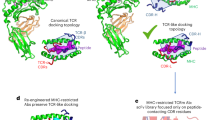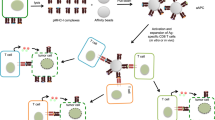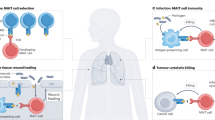Abstract
The ability to mimic peptide/peptide and/or peptide/carbohydrate structures may be important in generating cross-reactive antibodies for autoimmune and other diseases. We show that the peptide sequence DAHWESWL can mimic the conformation of the unrelated MUC1 peptide SAPDTRPAP(G). Mice immunized with mannan-MUC1-peptides make cytotoxic T lymphocytes (CTLs) and are protected from MUC1+ tumors. We show that the same specific anti-MUCI responses can be produced by immunizing with the DAHWESWL peptide; furthermore, specific tumor protection is obtained in a manner similar to that with MUC1 immunization. The DAHWESWL peptide immunization leads to CTLs that recognize H2Dd and H2Ld but not H2b or human leukocyte antigens–group A (HLA-A)*0201 presented MUC1 peptides. However, mutation of the DAHWESWL peptide to a more HLA-A*0201–compatible structure with appropriate anchors (DLHWASWV), leads to the production of CTLs in HLA-A*0201 mice.
This is a preview of subscription content, access via your institution
Access options
Subscribe to this journal
Receive 12 print issues and online access
$209.00 per year
only $17.42 per issue
Buy this article
- Purchase on Springer Link
- Instant access to full article PDF
Prices may be subject to local taxes which are calculated during checkout
Similar content being viewed by others
References
Singer, A. 1994. News: time and truth for cancer vaccines—a new generation. J. Natl. Cancer Inst. 86: 330–330.
Burchell, J., Papadimitriou, J.T., Boshell, M., Gendler, S.J. and Duhig, T. 1989. A short sequence within the amino acid tandem repeat of a cancer-associated mucin, contains immunodominant epitopes. Int. J. Cancer 44: 691–696.
Xing, P.X., Prenzoska, J., Quelch, K. and McKenzie, I.F.C. 1992. Second generation anti-MUCI peptide monoclonal antibodies. Cancer Res. 52: 2310–2317.
Burchell, J., Gendler, S., Taylor-Papadimitriou, J., Girling, A., Lewis, A., Millis, R., and Lamport, D. 1987. Development and characterisation of breast cancer reactive monoclonal antibodies directed to the core protein of the human milk mucin. Cancer Res. 47: 5476–5482.
Apostolopoulos, V., McKenzie, I.F.C., and Pietersz, G.A. 1996. Breast cancer immunotherapy—current status and future prospects. Immunol. Cell Biol. 74: 457–464.
Barnd, D.L., Lan, M.S., Metzgar, R.S., and Finn, O.J. 1989. MHC-unre-stricted recognition of tumor-associated mucins by human CTL. Proc. Natl. Acad. Sci. USA 86: 7159–7163.
Ioannides, C.G., Fisk, B., Jerome, K.R., Irimura, T., Wharton, J.T., and Finn, O.J. 1989. CTL from ovarian malignant tumors can recognize polymorphic epithelial mucin core peptides. J. Immunol. 151: 3693–3703.
Jerome, K.R., Domenech, N., and Finn, O.J. 1993. Tumor-specific CTL clones from patients with breast and pancreatic adenocarcinoma recognize EBV-immortalized B cells transfected with polymorphic epithelial mucin cDNA. J. Immunol. 151: 1654–1662.
Apostolopoulos, V., Pietersz, G.A., and McKenzie, I.F.C. 1996. Cell-mediated immune responses to MUC1 fusion protein coupled to mannan. Vaccine 14: 930–938.
Apostolopoulos, V., Pietersz, G.A., Loveland, B.E., Sandrin, M.S. and McKenzie, I.F.C. 1995. Oxidative/reductive conjugation of mannan to antigen selects for T, or T, immune responses. Proc. Natl. Acad. Sci. USA 92: 10128–10132.
Karanikas, V., Hwang, L., Pearson, J., Ong, C.S., Apostolopoulos, V., Vaughan, H.A., et al. 1997. Antibody and T cell responses of patients with adenocarcinoma immunized with mannan-MUC1 fusion protein. J. Clin. Invest. 100: 2783–2792.
Vaughan, H.A., Oldenburg, K.R., Gallop, M.A., Atkin, J.D., McKenzie, I.F.C., et al. 1996. Recognition of an octapeptide sequence by multiple Galα(1,3)Gal-binding proteins. Xenotransplantation 3: 18–23.
Sandrin, M.S., Vaughan, H.A., Xing, P.X., and McKenzie, I.F.C. 1997. Natural human anti-Galα(1,3)Gal antibodies react with human mucin peptides. Glycoconj. J. 14: 97–105.
Apostolopoulos, V., Haurum, J.S., and McKenzie, I.F.C. 1997. MUC1 peptide epitopes associated with 5 different H2 Class I molecules. Eur. J. Immunol. 27: 2579–2587.
Quaratino, S., Thorpe, C.J., Travers, P.J. and Londei, M. 1995. Similar antigenic surfaces, rather than sequence homology, dictate T-cell epitope molecular mimicry. Proc. Natl. Acad. Sci. USA 92: 10398–10402.
Apostolopoulos, V., Karanikas, V., Haurum, J., and McKenzie, I.F.C. 1997. Induction of HLA-A*0201 restricted cytotoxic T lymphocytes to the MUC1 human breast cancer antigen. J. Immunol. 159: 5211–5218.
Westerink, M.A.J., Giardinal, P.C., Apicella, M.A. and Emmons, T.K. 1995. Peptide mimicry of the meningococcal group C capsular polysaccharide. Proc. Natl. Acad. Sci. USA 92: 4021–025.
Wucherpfennig, K.W. and Strominger, J.L. 1995. Molecular mimicry in T cell mediated autoimmunity: viral peptides activate human T cell clones specific for myelin basic protein. Cell 80: 695–705.
Weiss, G.A., Valentekovich, R.J., Collins, E.J., Garboczi, D.N., Lane, W.S., Schreiber, S.L. et al. 1996. Covalent HLA-B27/peptide complex induced by specific recognition of an aziridine mimic of arginine. Proc. Natl. Acad. Sci. USA 93: 10945–10948.
Loftus, D.J., Castelli, C., Clay, T.M., Squarcina, P., Marincola, P.M., Nishimura, M.I. et al. 1996. Identification of epitope mimics recognized by CTL reactive to the melanoma/melanocyte-derived peptide MART-1 B7Ja. J. Exp. Med. 184: 647–657.
Blake, J., Johnston, J.V., Hellstrom, K.E., Marquardt, H. and Chen, L. 1996. Use of combinatorial peptide libraries to construct functional mimics of tumor epitopes recognized by MHC Class l-restricted cytolytic T lymphocytes. J. Exp. Med. 184: 121–30.
Apostolopoulos, V., Xing, P.X., Trapani, J.A. and McKenzie, I.F.C. 1993. Production of anti-breast cancer monoclonal antibodies using a glutathione-S-transferase-MUC1 bacterial fusion protein. Br. J. Cancer 67: 713–720.
Xing, P.X., Tjandra, J.J., Stacker, S.A., Teh, J.G., Thompson, C.H., McLaughlin, P.J. and McKenzie, I.F.C. 1989. Monoclonal antibodies reactive with mucin expressed in breast cancer. Immunol. Cell Biol. 67: 183–185.
Vitiello, A., Marchesini, D., Furze, J., Sherman, L.A. and Chestnut, R.W. 1991. Analysis of the HLA-restricted influenza-specific CTL response in transgenic mice carrying a chimeric human-mouse Class I MHC molecule. J. Exp. Med. 173:1007.
Apostolopoulos, V., Xing, P.X. and McKenzie, I.F.C. 1994. Murine immune response to cells transfected with human MUC1: immunization with cellular and synthetic antigens. Cancer Res. 54: 5186–5193.
Young, A.C.M., Zhang, W., Sacchettini, J.C. and Nathenson, S.G. 1994. The three-dimensional structure of H2Db at 2. 4Å resolution: implications for antigen-determinant selection. Cell 76: 39–50.
Chelvanayagam, G., Jakobsen, I.B., Gao, X. and Easteal, S. 1996. Structural comparison of major histocompatibility complex Class I molecules and homology modelling of five distinct human leucocyte antigen-A alleles. Protein Eng. 9: 1151–1164.
Fremont, D.H., Matsumura, M., Stura, E.A., Peterson, P.A. and Wilson, I.A. 1992. Crystal structure of two viral peptides in complex with MHC Class IH2Kb. Science 257: 919–926.
Madden, D.R., Gorga, J.C., Strominger, J.L. and Wiley, D.C. 1992. The three-dimensional structure of HLA-B27 at 2.1Å resolution suggests a general mechanism for tight peptide binding to MHC. Cell 70: 1035–1048
Madden, D.R., Garboczi, D.N. and Wiely, D.C. 1993. The antigenic identity of peptide-MHC complexes: a comparison of the conformations of five viral peptides presented by HLA-A*0201. Cell 75: 693–708.
Smith, K.J., Reid, S.W., Stuart, D.I., McMichael, A.J., Jones, E.Y. and Bell, J.I. 1996. An altered position of the alpha 2 helix of MHC Class I is revealed by the crystal structure of HLA-B*3501. Immunity 4: 202–214.
Fremont, D.H., Stura, E.A., Matsumura, M., Peterson, P.A. and Wilson, I.A. 1995. Crystal structure of an H2Kb-ovalbumin peptide complex reveals the interplay of primary and secondary anchor positions in the major histocompatibility complex binding groove. Proc. Natl. Acad. Sci. USA 92: 2479–2483.
Smith, K.J., Reid, S.W., Harlos, K., McMichael, A.J., Stuart, D.I., Bell, J.I. et al. 1996. Bound water structure and polymorphic amino acids act together to allow the binding of different peptides to MHC Class I HLA-B53. Immunity 4: 215–228.
Author information
Authors and Affiliations
Corresponding author
Rights and permissions
About this article
Cite this article
Apostolopoulos, V., Lofthouse, S., Popovski, V. et al. Peptide mimics of a tumor antigen induce functional cytotoxic T cells. Nat Biotechnol 16, 276–280 (1998). https://doi.org/10.1038/nbt0398-276
Received:
Accepted:
Issue Date:
DOI: https://doi.org/10.1038/nbt0398-276
This article is cited by
-
Immunisation with ‘naïve’ syngeneic dendritic cells protects mice from tumour challenge
British Journal of Cancer (2008)
-
Construction of a gene of the human tumor-associated antigen VNTR(MUC1) bound to streptavidin, its expression inEscherichia coli, and the study of properties of the hybrid protein
Russian Journal of Bioorganic Chemistry (2000)



